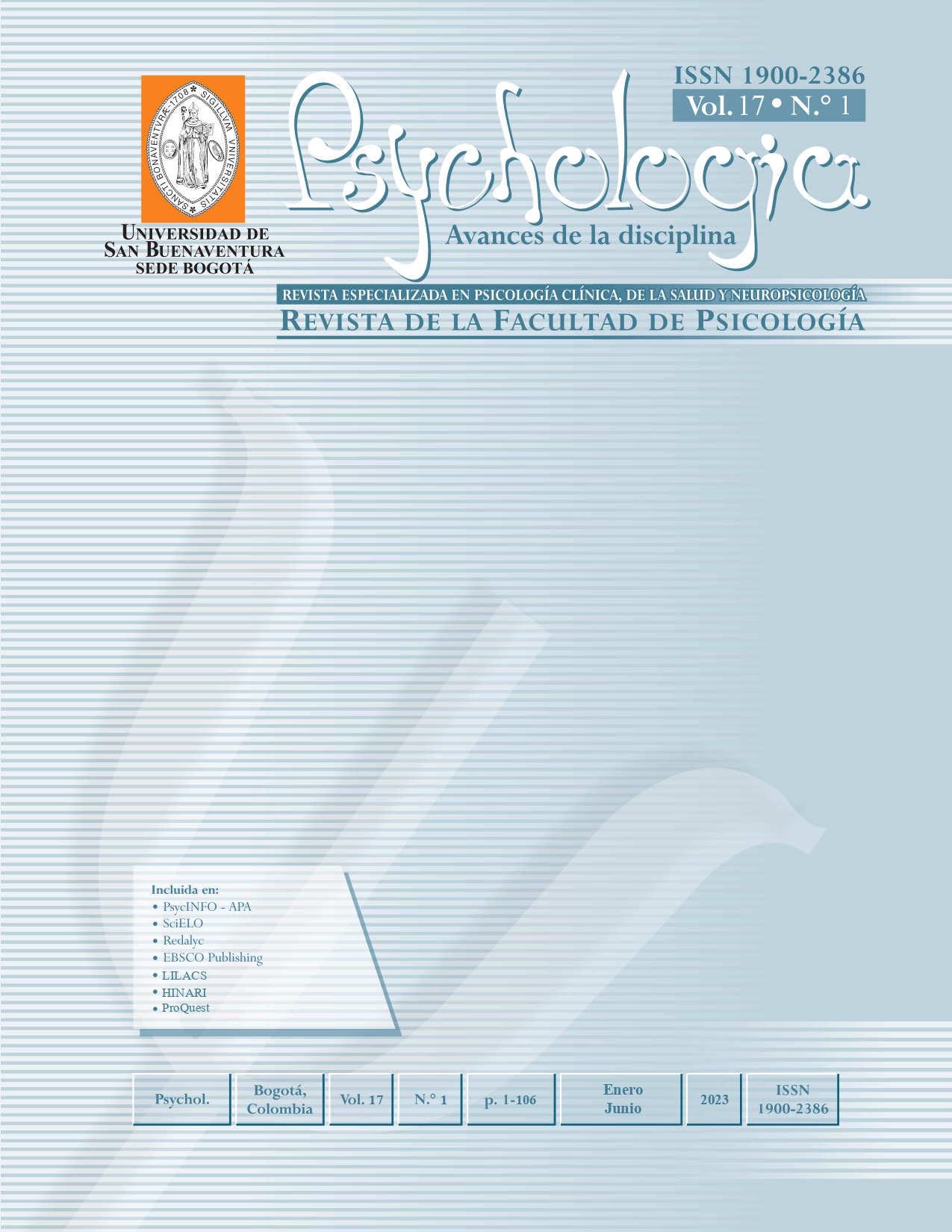Esta revista proporciona un acceso abierto inmediato a su contenido, basado en el principio de que ofrecer al público un acceso libre a las investigaciones ayuda a un mayor intercambio global de conocimiento.
Por tanto se acoge a la Licencia Creative Commons 4.0 Atribuciones Reconocimiento – NoComercial – CompartirIgual (by-nc-sa): No se permite un uso comercial de la obra original ni de las posibles obras derivadas, la distribución de las cuales se debe hacer con una licencia igual a la que regula la obra original.
http://creativecommons.org/licenses/by-nc-sa/4.0/
Resumen
Conforme pasa la edad, se reportan varios cambios funcionales, anatómicos y conductuales en funciones cognitivas, como la atención y memoria de trabajo. Sin embargo, parece que la valencia emocional de los estímulos tiene un efecto en el procesamiento de información. El objetivo de la presente revisión es exponer la hipótesis de que los mecanismos atencionales de amplificación de información relevante y supresión de información irrelevante repercuten sobre la eficiencia en la memoria de trabajo, y proponer que estos mecanismos pudieran ser vulnerables al efecto de la valencia emocional de los estímulos. En esta revisión se expondrán los diferentes modelos de atención que permitan comprender el concepto de filtrado de la información para realizar tareas de competencia emocional. También, se discutirá el efecto de los distractores neutros y con valencia emocional sobre la eficiencia en la memoria de trabajo, contrastando la evidencia existente entre adultos jóvenes vs. adultos mayores. Finalmente, se plantea la hipótesis de los mecanismos atencionales y su impacto en la memoria de trabajo. Hasta donde es nuestro conocimiento, se desconoce cómo cambian estos mecanismos atencionales a lo largo de la vida adulta, cómo la valencia emocional impacta estos mecanismos y, potencialmente, la eficiencia de la memoria de trabajo. Los adultos mayores presentan una disminución en el mecanismo de supresión en comparación con los jóvenes, efecto no observado para el mecanismo de amplificación. Conforme la edad avanza, la valencia emocional impacta diferencialmente la captura atencional. Se presume que los cambios tanto en los mecanismos atencionales como en la valencia emocional tienen un potencial efecto sobre la memoria de trabajo.
Palabras clave:
Referencias
Benavides-Caro, C. (2017). Deterioro cognitivo en el adulto mayor. Revista Mexicana de Anestesiología, 40(2), 107-112. https://www.medigraphic.com/pdfs/rma/cma-2017/cma172f.pdf
Black, M. H., Chen, N., Iyer, K. K., Lipp, O. V., Bölte, S., Falkmer, M., Tan, T., & Girdler, S. (2017). Mechanisms of facial emotion recognition in autism spectrum disorders: Insights from eye tracking and electroencephalography. Neuroscience and biobehavioral reviews, 80, 488-515. https://doi.org/10.1016/j.neubiorev.2017.06.016
Bonnefond, M., & Jensen, O. (2012). Alpha oscillations serve to protect working memory maintenance against anticipated distracters. Current biology, 22(20), 1969-1974. https://doi.org/10.1016/j.cub.2012.08.029
Borrás Blasco, C., & Viña Ribes, J. (2016). Neurofisiología y envejecimiento. Concepto y bases fisiopatológicas del deterioro cognitivo [Neurophysiology and ageing. Definition and pathophysiological foundations of cognitive impairment]. Revista española de geriatria y gerontologia, 51(1), 3-6. https://doi.org/10.1016/S0211-139X(16)30136-6
Bourgin, J., Silvert, L., Borg, C., Morand, A., Sauvée, M., Moreaud, O., & Hot, P. (2020). Impact of emotionally negative information on attentional processes in normal aging and Alzheimer's disease. Brain and cognition, 145, 105624. https://doi.org/10.1016/j.bandc.2020.105624
Buckner, R. L. (2004). Memory and executive function in aging and AD: multiple factors that cause decline and reserve factors that compensate. Neuron, 44(1), 195-208. https://doi.org/10.1016/j.neuron.2004.09.006
Burgoyne, A. P., & Engle, R. W. (2020). Attention Control: A Cornerstone of Higher-Order Cognition. Current Directions in Psychological Science, 29(6), 624-630. https://doi.org/10.1177/0963721420969371
Cabeza, R., Albert, M., Belleville, S., Craik, F. I. M., Duarte, A., Grady, C. L., Lindenberger, U., Nyberg, L., Park, D. C., Reuter-Lorenz, P. A., Rugg, M. D., Steffener, J., & Rajah, M. N. (2018). Maintenance, reserve and compensation: the cognitive neuroscience of healthy ageing. Nature reviews. Neuroscience, 19(11), 701-710. https://doi.org/10.1038/s41583-018-0068-2
Carboni, A., & Barg, G. (2016). Capítulo 3: Atención. En Vásquez, A. (Ed.), Manual de introducción a la psicología cognitiva (pp. 89-97). Comisión Sectorial de Enseñanza. https://xdoc.mx/preview/capitulo-3-manual-de-psicologia-cognitiva-5d6831bf770fe
Cárcamo, B. (2018). Modelos de la Memoria de Trabajo de Baddeley y Cowan: una revisión bibliográfica comparativa Modelos de memoria de trabajo: ¿dónde se encuentran? Rev. Chil. Neuropsicol., 13(1), 6-10. DOI: 10.5839/rcnp.2018.13.01.02
Carretié, L., Hinojosa, J. A., Martín-Loeches, M., Mercado, F., & Tapia, M. (2004). Automatic attention to emotional stimuli: neural correlates. Human brain mapping, 22(4), 290-299. https://doi.org/10.1002/hbm.20037
Carretié, L. (2014). Exogenous (automatic) attention to emotional stimuli: a review. Cognitive, affective & behavioral neuroscience, 14(4), 1228-1258. https://doi.org/10.3758/s13415-014-0270-2
Carstensen, L. L., Pasupathi, M., Mayr, U., & Nesselroade, J. R. (2000). Emotional experience in everyday life across the adult life span. Journal of Personality and Social Psychology, 79(4), 644-655. https://doi.org/10.1037/0022-3514.79.4.644
Carstensen, L. L. (2021). Socioemotional Selectivity Theory: The Role of Perceived Endings in Human Motivation. The Gerontologist, 61(8), 1188-1196. https://doi.org/10.1093/geront/gnab116
Charles, S. T., & Carstensen, L. L. (2010). Social and emotional aging. Annual review of psychology, 61, 383-409. https://doi.org/10.1146/annurev.psych.093008.100448
Chukwuorji, J. C., & Allard, E. S. (2022). The Age-Related Positivity Effect and Emotion Regulation: Assessing Downstream Affective Outcomes. International journal of aging & human development, 95(4), 455-469. https://doi.org/10.1177/00914150221077954
Clapp, W. C., Rubens, M. T., & Gazzaley, A. (2010). Mechanisms of working memory disruption by external interference. Cerebral cortex (New York, N.Y. : 1991), 20(4), 859-872. https://doi.org/10.1093/cercor/bhp150
Clapp, W. C., & Gazzaley, A. (2012). Distinct mechanisms for the impact of distraction and interruption on working memory in aging. Neurobiology of aging, 33(1), 134-148. https://doi.org/10.1016/j.neurobiolaging.2010.01.012
Cohen, R. A., Marsiske, M. M., & Smith, G. E. (2019). Neuropsychology of aging. Handbook of clinical neurology, 167, 149-180. https://doi.org/10.1016/B978-0-12-804766-8.00010-8
Cohen, A. A., Legault, V., & Fülöp, T. (2020). What if there's no such thing as "aging"? Mechanisms of ageing and development, 192, 111344. https://doi.org/10.1016/j.mad.2020.111344
Corbetta, M., & Shulman, G. L. (2002). Control of goal-directed and stimulus-driven attention in the brain. Nature reviews. Neuroscience, 3(3), 201–215. https://doi.org/10.1038/nrn755
Craik, F. I., & Salthouse, T. A. (Eds.). (2008). The Handbook of Aging and Cognition. New York and Hove: Psychology Press. https://doi.org/10.1017/S0714980800012332
Cristofori, I., Cohen-Zimerman, S., & Grafman, J. (2019). Executive functions. Handbook of clinical neurology, 163, 19-219. https://doi.org/10.1016/B978-0-12-804281-6.00011-2
D'Esposito M. (2007). From cognitive to neural models of working memory. Philosophical transactions of the Royal Society of London. Series B, Biological sciences, 362(1481), 761-772. https://doi.org/10.1098/rstb.2007.2086
Ding, L. J., Zhang, S. S., Peng, M., y Li, X. (2022). Aging and distractor resistance in working memory: Does emotional valence matter? BMC psychology, 10(1), 251. https://doi.org/10.1186/s40359-022-00953
Draheim, C., Tsukahara, J. S., Martin, J. D., Mashburn, C. A., & Engle, R. W. (2021). A toolbox approach to improving the measurement of attention control. Journal of experimental psychology. General, 150(2), 242-275. https://doi.org/10.1037/xge0000783
Ekman, P. (1984). Expression and the nature of emotion. En K. R. Scherer y P. Ekman (Eds.), Approaches to Emotions. Hillsdale: Erlbaum.
Feldmann-Wüstefeld, T., & Vogel, E. K. (2019). Neural Evidence for the Contribution of Active Suppression During Working Memory Filtering. Cerebral cortex (New York, N.Y. : 1991), 29(2), 529-543. https://doi.org/10.1093/cercor/bhx336
Gallant, S. N., Carvalho, M., Hansi, J., & Yang, L. (2020). The effect of emotional distraction on hyper-binding in young and older adults. Cognition & emotion, 34(4), 839-847. https://doi.org/10.1080/02699931.2019.1668750
Gaspelin, N., & Luck, S. J. (2019). Inhibition as a potential resolution to the attentional capture debate. Current opinion in psychology, 29, 12-18. https://doi.org/10.1016/j.copsyc.2018.10.013
Gazzaley, A., Cooney, J. W., Rissman, J., & D'Esposito, M. (2005). Top-down suppression deficit underlies working memory impairment in normal aging. Nature neuroscience, 8(10), 1298-1300. https://doi.org/10.1038/nn1543
Gazzaley, A., Cooney, J. W., McEvoy, K., Knight, R. T., & D'Esposito, M. (2005). Top-down enhancement and suppression of the magnitude and speed of neural activity. Journal of cognitive neuroscience, 17(3), 507-517. https://doi.org/10.1162/0898929053279522
Gazzaley A, Sheridan MA, Cooney JW., & D'Esposito M. (2007). Age-related deficits in component processes of working memory. Neuropsychology, 21(5), 532-539. https://doi.org/10.1037/0894-4105.21.5.532
Gazzaley A., Clapp W., Kelley J., McEvoy K., Knight R.T., & D’Esposito M. (2008). Age-related top-down suppression deficit in the early stages of cortical visual memory processing. Proc. Natl. Acad. Sci. USA, 105, 13122-13126. https://doi.org/10.1073/pnas.0806074105
Gazzaley, A., & Nobre. A. (2012). Top-down modulation: bridging selective attention and working memory. Trends in Cognitive Sciences, 16(2), 129-135. https://doi.org/10.1016/j.tics.2011.11.014
Gutiérrez de Piñares Botero, C. (2019). Registro de movimientos oculares con el eye tracker Mobile eye XG. Colección Logos Vestigium, 6, 41-46. ISBN: 978-958-5456-70-9
Horstmann, G., & Becker, S. I. (2020). More efficient visual search for happy faces may not indicate guidance, but rather faster distractor rejection: Evidence from eye movements and fixations. Emotion, 20(2), 206-216. https://doi.org/10.1037/emo0000536
Hutton S. B. (2008). Cognitive control of saccadic eye movements. Brain and cognition, 68(3), 327-340. https://doi.org/10.1016/j.bandc.2008.08.021
Isaacowitz D. M., Wadlinger H. A., Goren, D., & Wilson, H. R. (2006). Is there an age-related positivity effect in visual attention? A comparison of two methodologies. Emotion 6(3), 511-516. https://doi.org/10.1037/1528-3542.6.3.511
Jablonska, K., Piotrowska, M., Bednarek, H., Szymaszek, A., Marchewka, A., Wypych, M., & Szelag, E. (2020). Maintenance vs. Manipulation in Auditory Verbal Working Memory in the Elderly: New Insights Based on Temporal Dynamics of Information Processing in the Millisecond Time Range. Frontiers in aging neuroscience, 12, 194. https://doi.org/10.3389/fnagi.2020.00194
Kerzel, D., Gauch, A., & Ulmann, B. (2008). Local motion inside an object affects pointing less than smooth pursuit. Experimental brain research, 191(2), 187-195. https://doi.org/10.1007/s00221-008-1514-6
Kimmig, H., Greenlee, M. W., Gondan, M., Schira, M., Kassubek, J., & Mergner, T. (2001). Relationship between saccadic eye movements and cortical activity as measured by fMRI: quantitative and qualitative aspects. Experimental brain research, 141(2), 184–194. https://doi.org/10.1007/s002210100844
Kulke, L., Brümmer, L., Pooresmaeili, A., & Schacht, A. (2022). Visual competition attenuates emotion effects during overt attention shifts. Psychophysiology, 59(11), e14087. https://doi.org/10.1111/psyp.14087
Leclerc, C. M., & Kensinger, E. A. (2010). Age-related valence-based reversal in recruitment of medial prefrontal cortex on a visual search task. Social neuroscience, 5(5-6), 560-576. https://doi.org/10.1080/17470910903512296
Linares, R., Bajo, M. T., & Pelegrina, S. (2016). Age-related differences in working memory updating components. Journal of Experimental Child Psychology, 147, 39-52. https://doi.org/10.1016/j.jecp.2016.02.009
Liu, H., Liu, H., Li, F., Han, B., & Wang, C. (2021). Effect of Cognitive Control on Attentional Processing of Emotional Information Among Older Adults: Evidence From an Eye-Tracking Study. Frontiers in aging neuroscience, 13, 644379. https://doi.org/10.3389/fnagi.2021.644379
Löckenhoff, C. E., & Carstensen, L. L. (2004). Socioemotional selectivity theory, aging, and health: the increasingly delicate balance between regulating emotions and making tough choices. Journal of personality, 72(6), 1395-1424. https://doi.org/10.1111/j.1467-6494.2004.00301.x
Maniglia, M. R., & Souza, A. S. (2020). Age Differences in the Efficiency of Filtering and Ignoring Distraction in Visual Working Memory. Brain sciences, 10(8), 556. https://doi.org/10.3390/brainsci10080556
Marshall, L., y Bays P. M. (2013). Obligatory encoding of task-irrelevant features depletes working memory resources. Journal of Vision, 13(21). https://doi.org/10.1167/13.2.21
Mather, M. (2016). The Affective Neuroscience of Aging. Annual review of psychology, 67, 213-238. https://doi.org/10.1146/annurev-psych-122414-033540
McNab, F., Zeidman, P., Rutledge, R. B., Smittenaar, P., Brown, H. R., Adams, R. A., & Dolan, R. J. (2015). Age-related changes in working memory and the ability to ignore distraction. Proceedings of the National Academy of Sciences of the United States of America, 112(20), 6515-6518. https://doi.org/10.1073/pnas.1504162112
McSorley, E., & McCloy, R. (2009). Saccadic eye movements as an index of perceptual decision-making. Experimental brain research, 198(4), 513-520. https://doi.org/10.1007/s00221-009-1952-9
Mertes, C., Wascher, E., & Schneider, D. (2017). Compliance instead of flexibility? On age-related differences in cognitive control during visual search. Neurobiology of aging, 53, 169-180. https://doi.org/10.1016/j.neurobiolaging.2017.02.003
Mulckhuyse, M. (2018). The influence of emotional stimuli on the oculomotor system: A review of the literature. Cognitive, affective & behavioral neuroscience, 18(3), 411-425. https://doi.org/10.3758/s13415-018-0590-8
Nielsen, S., & Wilms, I. L. (2015). Cognitive aging on latent constructs for visual processing capacity: a novel structural equation modeling framework with causal assumptions based on a theory of visual attention. Frontiers in Psychology, 5, 1-13. https://doi.org/10.3389/fpsyg.2014.01596
Norman, D. A. (1968). Toward a theory of memory and attention. Psychological Review, 75, 522-536.
Nyberg, L., & Eriksson, J. (2015). Working Memory: Maintenance, Updating, and the Realization of Intentions. Cold Spring Harbor perspectives in biology, 8(2), a021816. https://doi.org/10.1101/cshperspect.a021816
Ong, A. D., Bergeman, C. S., Bisconti, T. L., & Wallace, K. A. (2006). Psychological resilience, positive emotions, and successful adaptation to stress in later life. Journal of personality and social psychology, 91(4), 730-749. https://doi.org/10.1037/0022-3514.91.4.730
Ong, A. D., Bergeman, C. S., & Boker, S. M. (2009). Resilience comes of age: defining features in later adulthood. Journal of personality, 77(6), 1777-1804. https://doi.org/10.1111/j.1467-6494.2009.00600.x
Park, Y. E., Sy, J. L., Hong, S. W., & Tong, F. (2017). Reprioritization of Features of Multidimensional Objects Stored in Visual Working Memory. Psychological science, 28(12), 1773-1785. https://doi.org/10.1177/0956797617719949
Pehlivanoglu, D., & Verhaeghen, P. (2019). Now you feel it, now you don't: Motivated attention to emotional content is modulated by age and task demands. Cognitive, affective & behavioral neuroscience, 19(5), 1299-1316. https://doi.org/10.3758/s13415-019-00741-z
Pessoa, L., Medina, L., Hof, P. R., & Desfilis, E. (2019). Neural architecture of the vertebrate brain: implications for the interaction between emotion and cognition. Neuroscience and biobehavioral reviews, 107, 296-312. https://doi.org/10.1016/j.neubiorev.2019.09.021
Petro, N. M., Basyouni, R., & Neta, M. (2021). Positivity effect in aging: evidence for the primacy of positive responses to emotional ambiguity. Neurobiology of aging, 106, 232-240. https://doi.org/10.1016/j.neurobiolaging.2021.06.015
Pourtois, G., De Pretto, M., Hauert, C. A., & Vuilleumier, P. (2006). Time course of brain activity during change blindness and change awareness: performance is predicted by neural events before change onset. Journal of cognitive neuroscience, 18(12), 2108-2129. https://doi.org/10.1162/jocn.2006.18.12.2108
Ríos-Lago, M., Adrover-Roig, D., Martínez, D., & Sánchez, J. (2013). La atención. Neurociencia cognitiva, 1(18), 1-18. Editorial Médica Panamericana.
Román-López, T. V., Caballero-Sánchez, U., Cisneros-Luna, S., Franco-Rodríguez, J. A., Méndez-Díaz, M., Prospéro-García, O., & Ruiz-Contreras, A. E. (2019). Brain electrical activity from encoding to retrieval while maintaining and manipulating information in working memory. Memory (Hove, England), 27(8), 1063-1078. https://doi.org/10.1080/09658211.2019.1620287
Rösler, A., Ulrich, C., Billino, J., Sterzer, P., Weidauer, S., Bernhardt, T., Steinmetz, H., Frölich, L., & Kleinschmidt, A. (2005). Effects of arousing emotional scenes on the distribution of visuospatial attention: changes with aging and early subcortical vascular dementia. Journal of the neurological sciences, 229-230, 109-116. https://doi.org/10.1016/j.jns.2004.11.007
Ruiz-Contreras, A., & Cansino, S. (2005). Neurofisiología de la interacción entre la atención y la memoria episódica: revisión de estudios en modalidad visual. Revista de neurología, 41(12), 733-743. https://doi.org/10.33588/rn.4112.200461
Sasse, L. K., Gamer, M., Büchel, C., & Brassen, S. (2014). Selective control of attention supports the positivity effect in aging. PloS one, 9(8), e104180. https://doi.org/10.1371/journal.pone.0104180
Schwabe, L., Merz, C. J., Walter, B., Vaitl, D., Wolf, O. T., & Stark, R. (2011). Emotional modulation of the attentional blink: the neural structures involved in capturing and holding attention. Neuropsychologia, 49(3), 416-425. https://doi.org/10.1016/j.neuropsychologia.2010.12.037
Shalev, N., Brosnan, M. B., & Chechlacz, M. (2020). Right Lateralized Brain Reserve Offsets Age-Related Deficits in Ignoring Distraction. Cerebral cortex communications, 1(1), tgaa049. https://doi.org/10.1093/texcom/tgaa049
St Jacques, P. L., Bessette-Symons, B., & Cabeza, R. (2009). Functional neuroimaging studies of aging and emotion: fronto-amygdalar differences during emotional perception and episodic memory. Journal of the International Neuropsychological Society: JINS, 15(6), 819-825. https://doi.org/10.1017/S1355617709990439
Torres, R. E., Emrich, S. M., & Campbell, K. L. (2023). Age differences in the use of positive and negative cues to filter distracting information from working memory. Attention, perception & psychophysics, 85(4), 1207-1218. https://doi.org/10.3758/s13414-023-02695-4
Vuilleumier P. (2005). How brains beware: neural mechanisms of emotional attention. Trends in cognitive sciences, 9(12), 585-594. https://doi.org/10.1016/j.tics.2005.10.011
Wang, J., Xie, F., He, L., Meadmore, K. L., Paterson, K. B., & Benson, V. (2020). Eye movements reveal a similar positivity effect in Chinese and UK older adults. Quarterly journal of experimental psychology, 73(11), 1921-1929. https://doi.org/10.1177/1747021820935861
Wascher, E., Heppner, H., Kobald, S. O., Arnau, S., Getzmann, S., & Möckel, T. (2016). Age-Sensitive Effects of Enduring Work with Alternating Cognitive and Physical Load. A Study Applying Mobile EEG in a Real Life Working Scenario. Frontiers in human neuroscience, 9, 711. https://doi.org/10.3389/fnhum.2015.00711
Weaver, M. D., van Zoest, W., & Hickey, C. (2017). A temporal dependency account of attentional inhibition in oculomotor control. NeuroImage, 147, 880-894. https://doi.org/10.1016/j.neuroimage.2016.11.004
Wieser, M. J., Hambach, A., & Weymar, M. (2018). Neurophysiological correlates of attentional bias for emotional faces in socially anxious individuals - Evidence from a visual search task and N2pc. Biological psychology, 132, 192-201. https://doi.org/10.1016/j.biopsycho.2018.01.004
Zanto, T. P., & Gazzaley, A. (2009). Neural suppression of irrelevant information underlies optimal working memory performance. The Journal of neuroscience: the official journal of the Society for Neuroscience, 29(10), 3059-3066. https://doi.org/10.1523/JNEUROSCI.4621-08.2009
Zanto, T. P., & Gazzaley, A. (2019). Aging of the frontal lobe. Handbook of clinical neurology, 163, 369-389. https://doi.org/10.1016/B978-0-12-804281-6.00020-3
Zebrowitz, L. A., Boshyan, J., Ward, N., Gutchess, A., & Hadjikhani, N. (2017). The Older Adult Positivity Effect in Evaluations of Trustworthiness: Emotion Regulation or Cognitive Capacity? PloS one, 12(1), e0169823. https://doi.org/10.1371/journal.pone.0169823
Ziaei, M., Peira, N., & Persson, J. (2014). Brain systems underlying attentional control and emotional distraction during working memory encoding. NeuroImage, 87, 276-286. https://doi.org/10.1016/j.neuroimage.2013.10.048
Ziaei, M., Barsam, A., Shamie, N., Vroman, D., Kim, T., Donnenfeld, E. D., Holland, E. J., Kanellopoulos, J., Mah, F. S., Randleman, J. B., Daya, S., Güell, J., & ASCRS Cornea Clinical Committee (2015). Reshaping procedures for the surgical management of corneal ectasia. Journal of cataract and refractive surgery, 41(4), 842-872. https://doi.org/10.1016/j.jcrs.2015.03.010
Ziaei, M., Samrani, G., & Persson, J. (2018). Age differences in the neural response to emotional distraction during working memory encoding. Cognitive, affective & behavioral neuroscience, 18(5), 869-883. https://doi.org/10.3758/s13415-018-0610-8
Zuber, S., Ihle, A., Loaiza, V. M., Schnitzspahn, K. M., Stahl, C., Phillips, L. H., Kaller, C. P., & Kliegel, M. (2019). Explaining age differences in working memory: The role of updating, inhibition, and shifting. Psychology & Neuroscience, 12(2), 191-208. https://doi.org/10.1037/pne0000151





















